Representing an integral part of Japan’s cultural legacy, Japanese kimonos are renowned for their timeless elegance and remarkable beauty. These Japanese traditional clothes have adorned both men and women for centuries, embodying the essence of Japanese identity and heritage. Vibrant colors and patterns further enhance their visual allure, making Japanese kimonos a captivating symbol of tradition and refinement. Their ability to enchant individuals worldwide is a testament to their enduring appeal.
What is a Japanese Kimono?
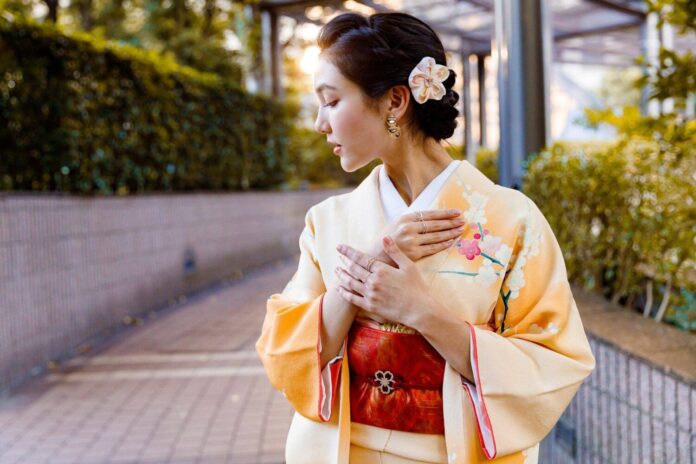
Japanese kimonos have been an essential element of Japanese culture for countless generations. The term “kimono” derives from the Japanese words meaning “thing to wear,” highlighting its fundamental role as clothing. Kimonos feature distinct characteristics, including their straight-seamed construction, T-shaped silhouette, and flowing sleeves. Typically crafted from lavish silk or lightweight cotton materials, kimonos are embellished with elaborate patterns and secured with an obi, a wide belt worn around the waist. Their style, design, and level of formality vary, catering to diverse occasions and genders.
Historical Background Of Japanese Kimonos
The kimono is a Japan traditional dress that has become synonymous with Japan’s cultural identity. Its origins can be traced back to ancient times when the precursors of the modern-day kimono emerged.
- During the Jomon period (14,000-300 BCE), the earliest known inhabitants of Japan, people wore rudimentary clothing made from animal hides and plant fibers. These early garments were simple in design, consisting of wrapped or draped fabric held together with cords or belts.
- The Yayoi period (300 BCE-300 CE), there was an influx of cultural influences from mainland Asia. This period marked the introduction of weaving techniques and the cultivation of silk and hemp. The shift from animal hides to woven fabrics.
- The true precursor to the modern Japanese kimono emerged during the Nara period (710-794) and Heian period (794-1185). The aristocratic class, heavily influenced by Chinese culture, adopted a more sophisticated clothing style. Known as the “kosode”. This garment featured straight-cut sleeves and a T-shaped structure. It was primarily worn as an undergarment by both men and women, paired with other layers of clothing. Kosode is the direct predecessor of the modern Japanese kimono.
- By the Kamakura period (1185-1333), the kosode underwent further modifications, leading to the birth of the modern Japanese kimono as we know it today. The sleeves became wider, and the garment grew in length, reaching the ankles. The obi, a wide sash, was introduced to secure the kimono and add a decorative element.
- The Muromachi period (1336-1573) witnessed significant changes in Japanese kimono fashion, influenced by the samurai class and the Zen Buddhist philosophy. Patterns inspired by nature, such as flowers and birds, began to appear on the fabric.
- During the Edo period (1603-1868), the Japanese kimono became a symbol of social status and aesthetic expression.
- With the Meiji period (1868-1912) and Japan’s modernization, Western clothing styles gained popularity, and the Japanese kimono faced challenges to its dominance. However, the Japanese kimono continued to be worn on formal occasions.
Today, the Japanese kimono has transcended its historical boundaries and has become a globally recognized fashion statement, appreciated for its timeless elegance and exquisite craftsmanship.
Reasons You Must Have a Japanese Kimono
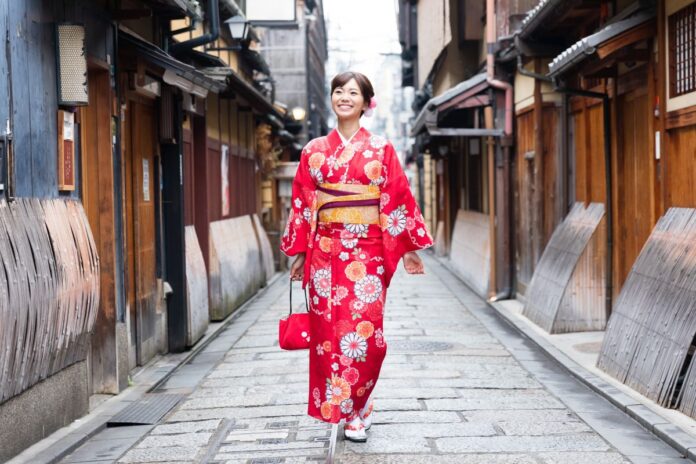
This Japanese traditional attire along with Geta sandals hold a rich cultural significance and has captivated people around the world with its beauty and elegance.
Appreciation for Japanese Culture
One of the main reasons to buy a Japanese kimono is your deep admiration for Japanese culture. Japan is renowned for its unique customs, artistry, and attention to detail.
Symbol of Tradition and History
The Japanese kimono carries a profound sense of tradition and history. It has been worn for centuries, evolving in style and design while preserving its essence. By owning a Japanese kimono, one will be partaking in this historical continuum, paying homage to the artisans.
Best for Special Occasions and Events
Japanese kimonos are often worn on special occasions and events, such as festivals, weddings, or tea ceremonies. Owning a Japanese kimono provides me with the opportunity to participate in these cultural events authentically.
Personal Connection and Self-Expression
Beyond its cultural significance, owning a Japanese kimono holds personal meaning for individuals. It represents a form of self-expression and allows individuals to connect with their own sense of style and identity.
A modern Japanese kimono, not only acquire a beautiful piece of clothing but also become part of a cultural legacy that continues to inspire and fascinate people worldwide.
Japanese Kimonos for Aesthetic Appeal
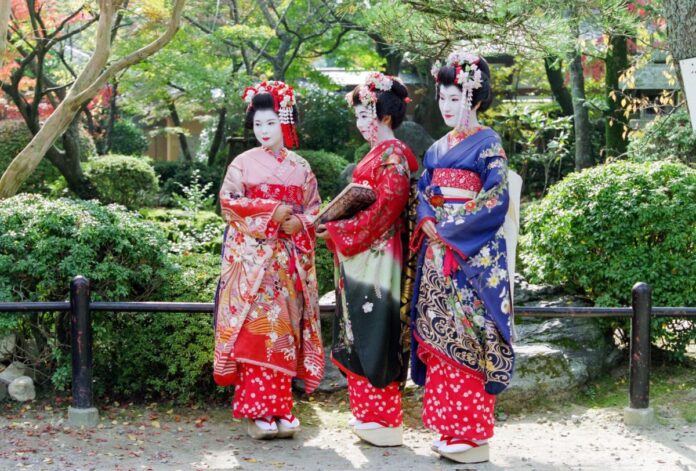
The timeless beauty and cultural significance of the traditional Japanese kimono have captured the hearts of people worldwide. Adorned with intricate designs, vibrant colors, and an elegant silhouette, the Japanese kimono exudes a distinct and enchanting aesthetic appeal that serves as a constant inspiration for fashion trends and artistic endeavors.
Menes Japanese Kimonos
While Japanese kimonos are often associated with women, there are also specific types of Japanese kimonos designed for men. Let’s discuss a few famous types of men’s kimonos.
- Yukata: The Japanese Yukata is a lightweight, casual kimono often worn during the summer months and at festivals. Japanese Yukata for men is usually simpler in design, featuring subdued colors and minimal patterns.
- Jinbaori: The jinbaori is a sleeveless kimono-like garment originally worn as armor by samurais.
- Haori: The Japanese Haori is a traditional Japanese jacket that can be worn over a Japanese kimono. It is typically made of silk.
- Komon: The Komon is a casual Japanese kimono that features repeated patterns all over its fabric. While kimonos are commonly worn by women, there are also designs specifically tailored for men.
- Montsuki: The montsuki is a formal men’s Japanese kimono worn on special occasions such as weddings, tea ceremonies, or other formal events. It is characterized by its solid black color and features a family crest (kamon) on the back and chest.
Japanese Kimonos Female
Japanese Kimonos are available in a variety of styles, colors, and patterns, each representing different meanings and occasions at the best online store. Then are some popular types of Japanese kirtles for ladies. Let’s explore the famous types of Japanese kimonos female.
- Furisode: Furisode is a type of Japanese kimono female characterized by its long, swinging sleeves. It is considered the most formal and luxurious style.
- Houmongi: Houmongi is a semi-formal Japanese kimono that can be worn by both married and unmarried women. It features patterns that flow over the shoulders and across the seams.
- Komon: Komon is a casual Japanese kimono with a repeated pattern throughout the garment. It is suitable for everyday wear or informal gatherings.
- Tomesode: Tomesode is a formal Japanese kimono mainly worn by married women during special occasions such as weddings or formal receptions. It features a solid black color with elegant patterns on the lower half, sleeves, and back.
- Yukata: Japanese yukata is a lightweight, casual Japanese kimono typically worn during summer festivals or hot spring outings. It is made from cotton or synthetic fabric.
- Uchikake: Uchikake is an elaborate and heavily embroidered outer Japanese kimono. It is often worn by brides during traditional Japanese weddings.
What Makes Our Japanese Kimonos Best?
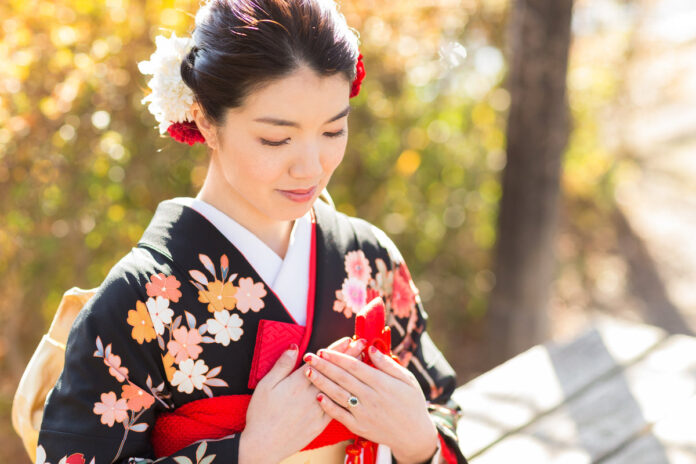
When it comes to kimono fashion, our collection stands out for several compelling reasons. Each Japanese kimono we offer embodies a unique blend of elegance, versatility, and cultural heritage. Let’s delve into the key aspects that make our Japanese kimonos the best choice for discerning fashion enthusiasts.
The Japanese Kimono’s Graceful Silhouette
Our Japanese kimonos are meticulously crafted to showcase a graceful silhouette that exudes timeless beauty. The flowing lines and carefully designed proportions ensure a flattering fit for a range of body types. The artistry lies in the balance between the loose, relaxed fit and the way the kimono drapes, creating an effortlessly elegant look that is both comfortable and stylish.
Types and Styles of Japanese Kimonos
We take pride in offering a diverse range of Japanese kimono types and styles, catering to different preferences and occasions. From the classic and iconic foreside, with its long flowing sleeves that symbolize youth and celebration, to the sleek and sophisticated Japanese kimono, suitable for everyday wear, our collection encompasses the rich tapestry of kimono fashion. Whether you’re seeking a traditional ceremonial kimono or a modern interpretation for contemporary fashion, we have options that will captivate your imagination.
Traditional Patterns and Motifs Used In Japanese Kimono Designs
The intricate patterns and motifs adorning our Japanese kimonos pay homage to Japan’s rich cultural heritage. Our designers meticulously select traditional motifs that carry deep symbolism and meaning, infusing each Japanese kimono with a story to be told. Our kimonos showcase the breadth of Japanese design aesthetics. Immerse yourself in the captivating world of Japanese kimono patterns and let them become a reflection of your personal style.
The wide array of styles available, and the incorporation of traditional patterns and motifs. Each Japanese kimono is a wearable work of art that allows you to embrace the grace and heritage of Japanese culture while making a fashion statement. Discover the allure of our Japanese kimonos and experience the epitome of elegance and style.
Tips for Kimono Care and Maintenance
Remember, proper care and maintenance is crucial to ensure the longevity of your Japanese kimono. By following these tips, you can enjoy your Japanese kimono for years to come while preserving its beauty and cultural significance.
- Ironing and Steaming: To remove wrinkles from your Japanese kimono, use a steamer or a cool iron with a pressing cloth. Avoid using high heat.
- Dry Cleaning: Due to the intricate designs, delicate fabrics, and potential for color bleeding, it’s recommended to take your Japanese kimono to a professional dry cleaner.
- Handling Odors: If your Japanese kimono develops an unpleasant odor, avoid using strong perfumes or sprays directly on the garment. Instead, hang the Japanese kimono in a well-ventilated area.
- Spot Cleaning: If you notice a small stain or spill on your Japanese kimono, Use a mild detergent specifically formulated for delicate fabrics and gently dab the affected area with a clean cloth or sponge. Avoid rubbing or scrubbing vigorously.
- Avoid Direct Sunlight: Prolonged exposure to sunlight can fade the vibrant colors of your Japanese kimono. When wearing or storing the garment, avoid placing it in direct sunlight.
- Proper Storage: When not wearing your Japanese kimono, Fold the kimono along its length and store it in a breathable garment bag or drawer, away from direct sunlight, moisture, and pests.
Final Thoughts on the Timeless Beauty of Japanese Kimonos
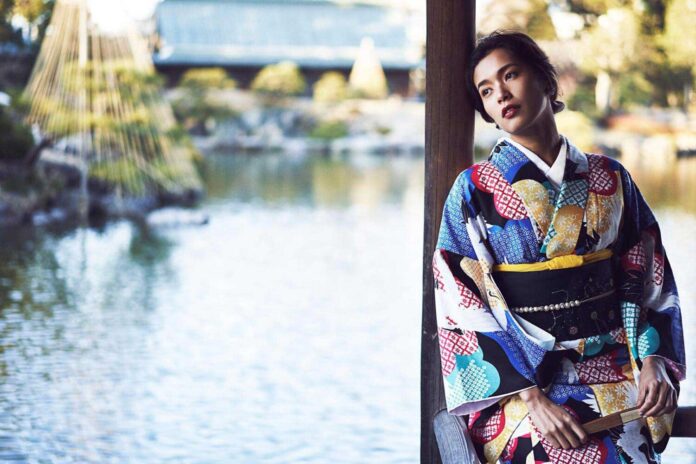
When it comes to kimonos from Japan, there is a wide variety of styles and designs to explore. Each region of Japan has its own unique approach to kimono production, resulting in distinctive characteristics and patterns. For example, the vibrant and bold colors of the Kyo-Yuzen kimonos from Kyoto, or the refined and elegant motifs of the Edo Komon kimonos from Tokyo, all showcase the diverse beauty of traditional Japanese craftsmanship.
FAQs
What Is A Japanese Kimono?
A Japanese kimono is a traditional garment worn in Japan. It is a T-shaped robe with wide sleeves and a wraparound style that is secured with a sash called an obi.
Can A Japanese Kimono Be Tailored To Fit?
Yes, Japanese kimonos can be tailored to some extent. However, traditional kimono construction is based on specific measurements and proportions. Altering a Japanese kimono’s size may involve significant changes to the garment.
Can Anyone Wear A Japanese Kimono?
Yes, anyone can wear a Japanese kimono. Kimonos are not limited to a specific gender or age group. However, the styling, fabric, and patterns of the Japanese kimono may vary depending on factors such as gender, age, and the occasion it is worn for.
What Occasions Are Japanese Kimonos Worn For?
Japanese kimonos are worn for various special occasions and events in Japan, such as weddings, tea ceremonies, festivals, and formal gatherings.

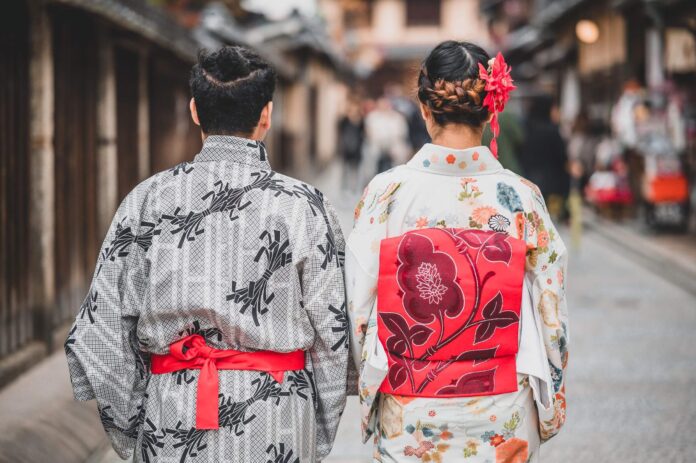



![Calgary’s Hottest Neighborhoods for Luxury Homebuyers [2024]](https://thewashingtonote.com/wp-content/uploads/2024/04/Calgary-324x160.png)



